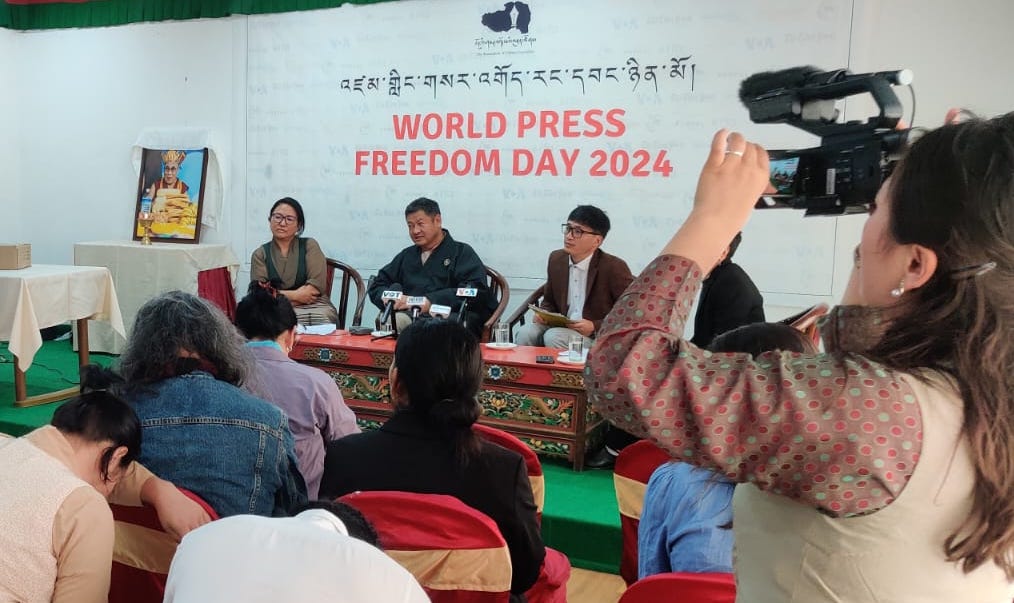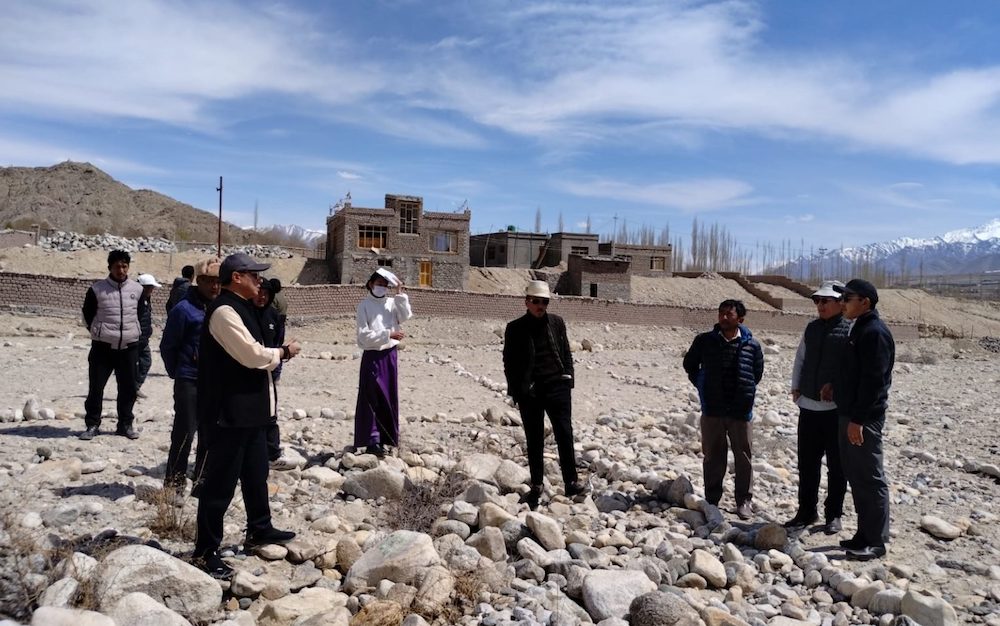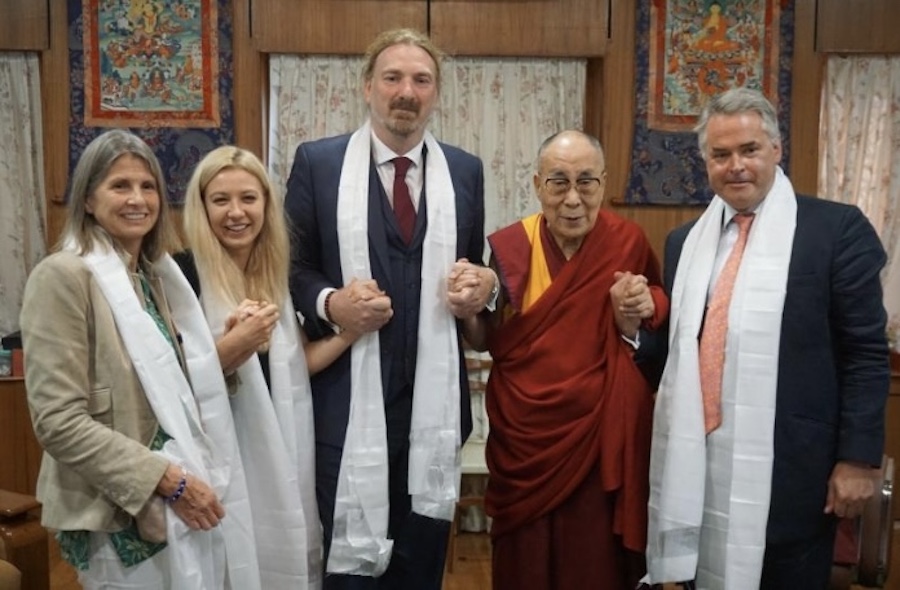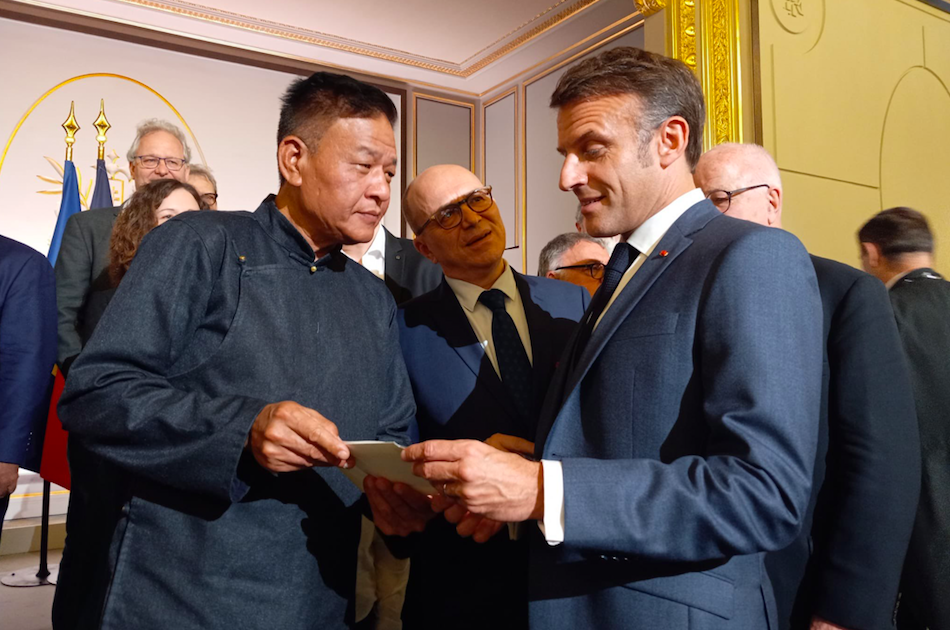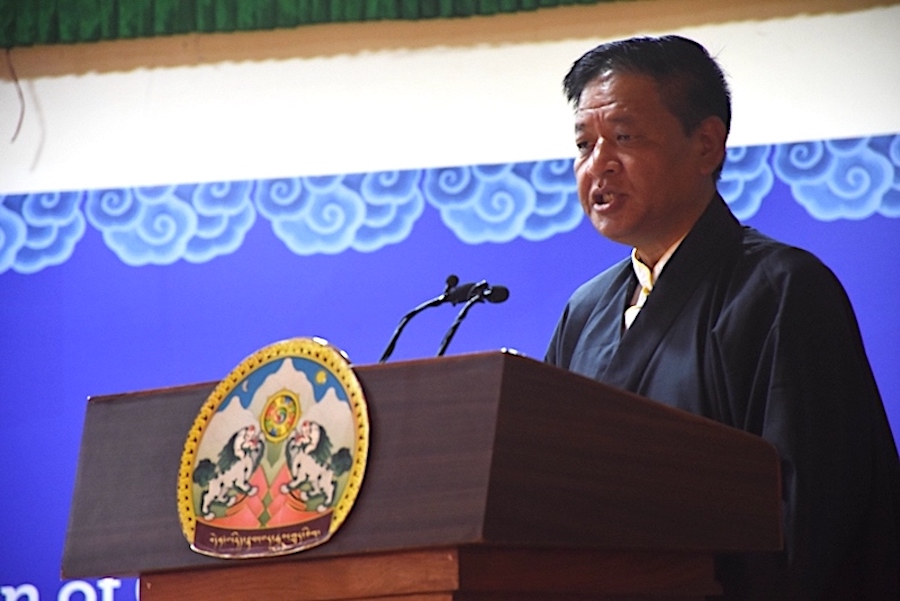By Josh Schrei
"When any government… undertakes to say to its subjects, ‘This you may not read, this you must not see, this you are forbidden to know,’ the end result is tyranny and oppression. Mighty little force is needed to control a man whose mind has been hoodwinked; contrariwise, no amount of force can control a man whose mind is free. No, not the rack, not fission bombs, not anything—you can’t conquer a free man; the most you can do is kill him."
—Robert A. Heinlein, writing nine years before the Chinese invasion of Tibet.
Life happens at the level of events, not of words. Trust only movement.
—Alfred Adler
"The Beijing Olympics will not be about sport, it will be about creating a superbrand called ‘China,’ and the brand essence is progress."
—Anonymous China marketing expert speaking on Ogilvy-Mathers’ hiring as marketing firm on the Beijing Olympics account
When the last significant pro-independence protests and subsequent riots happened in Tibet nineteen years ago, the world was a very different place. There was no Internet. Very few in the western world knew where Tibet was, let alone anything of its tragic history. Lhasa, though militarily occupied, was still for the most part a Tibetan town. So back then, when the Chinese government responded to the pro-independence riots/protests in its typical manner — arbitrary arrests and detentions, forced confessions, coercion, intimidation, torture, and execution via bullet to the back of the skull — there were very few in the world who took note. At that point in history, the stakes were low for the Chinese government. Although it was 17 years after the great ‘opening of China’ in 1972, Deng Xiaoping was still flirting with how to proceed with China’s economic and political development, and the Chinese didn’t need international opinion on their side — they were a still a relatively isolated nation, a second tier economy, not quite part of the international community, and they certainly didn’t care what – if anything – the Western world had to say about how they managed their ‘internal affairs’ in Tibet. Even the sting of the Dalai Lama winning the Nobel Peace Prize later that year was tempered by a general attitude of indifference towards Western opinion.
Since then, a lot has happened. China has ‘opened up’, in its own unique state-controlled way. They’ve been admitted to the WTO, gained permanent Most Favored Nation trading status with the United States, and secured billions of dollars in corporate capital and international development funds. Along the way, the Chinese government has walked a delicate tightrope, seeking to raise their population’s standard of living while maintaining a totalitarian grip on their country’s political process and on the information available to its citizenry.
Over the last 19 years, the Chinese government has weathered a growing Tibetan pro-independence movement active, for the most part until this week, outside of the country’s borders. They’ve taken the occasional wrist slaps from world leaders over their rights policies in Tibet, suffered through the negative publicity of two damning Hollywood films (Kundun and Seven Years in Tibet) and high profile concerts, dealt with the annoyance of protests whenever and wherever their leaders travel abroad, and grumbled loudly over the Dalai Lama’s continued popularity among world citizens and world governments.
But though they may grumble about the Dalai Lama and gripe about the relatively harmless – though consistent – nonviolent movement that Tibetans and Tibetan rights advocates have waged since 1989, Beijing has also benefited greatly from the Dalai Lama’s pacifist stance. For if anything over the last two decades has kept the Tibetan population from doing exactly what they did this week, it has been the Dalai Lama’s steadfast devotion to nonviolence and his insistence that his people maintain a similar moral high ground. If, for all these years, the Dalai Lama had been fomenting a violent uprising, Tibet – for better or worse – would be a very different place.
So, in this state of strange stasis, propped up by the funds of Fortune 500 companies salivating to exploit the PRC’s 1.2 billion person market, and inadvertently aided by a Tibetan population living relatively ‘peacefully’ in fear of reprisal and in deep internal conflict due to their Buddhist beliefs, the Chinese government has managed to – and been tacitly allowed to – spend the last 20 years constructing the most elaborate house of lies since Joe Stalin’s Russia. In a strange nod to outdated mid-20th century thinking, somehow the great powers of the world have collectively accepted that one their own, a nation who shares their table at the UN Security Council, is in fact a nation run by a non-elected government, whose people have never tasted democracy, who blocks all access to free information, and whose version of approved knowledge is – to put it bluntly – total fabrication. Absolute lies.
The lies run deep. Day in and day out, the Chinese government’s Xinhua News Agency – which Reporters Without Borders has labeled the single biggest propaganda machine in the world — has done its work. Over the years, Xinhua has repeatedly painted the Dalai Lama as a treasonous snake, grossly exaggerated Chinese economic growth claims, acted as a pipeline for anti-Taiwanese propaganda, encouraged hatred towards the decidedly odd but mostly benign Falun Gong movement, labeled nonviolent Tibetans as ‘terrorists,’ and placed a media blackout on Tibet and all issues Tibetan unless approved by state censors. Meanwhile the Chinese government has blocked whatever Internet sites it sees unfit for its population’s consumption and rewritten Tibetan history in everything from textbooks to Internet search results (one of the first governments to use SEO to their own nefarious ends). In Tibet, the Internet cafes are monitored to the point that one wrong word in an email (Hi Mom and Dad, Lhasa’s lovely right now, but the people seem a little stressed by the number of soldiers on the streets…‘) can result in a surprisingly quick visit from the PSB, and the number of surveillance cameras has grown faster than the number of Chinese-run shops.
More insidiously, the Chinese government has launched a deliberate program to infiltrate academic communities with Beijing’s versions of history, which are – how shall we say this – completely wrong. Back in the day, Tibet supporters like myself only had to deal with the occasional scruffy olive-clad western Maoist from Northern California expounding the virtues of the Great Leap Forward (in which millions of people died from execution, disease, and starvation) and condemning the ‘backward-feudal-serfdom’ that was Tibet. Now, the propaganda has taken a more professional turn, with slick government-approved websites, glossy publications like ‘China’s Tibet’, and – more disturbingly – an increased number of Western historians (and quasi-historians like Tom ‘Tibetans eat their own placenta’ Grunfeld and Michael Parenti) quoting Chinese government statistics as fact.
All this work – and keeping simple truths veiled for 20 years is indeed work – has paid off. The Chinese propaganda machine is effective to the point that even die hard Tibet activists like myself have admittedly had, over the last two decades, occasional twinges of propaganda-infused doubt. In the absence of an overtly visible people’s movement within Tibet, and with the presence of a constant barrage of increasingly sophisticated propaganda, even staunch Tibet supporters have sometimes wondered: ‘Is economic development bringing happiness to Tibetans? Are things as bad as people say? Maybe development in China will trickle down to Tibet. Maybe it’s just a matter of time…
It takes a lot of work to keep an information lockdown on an entire nation, to cast veils of doubt over what is actually a very simple situation, but China has done it well.
Now, all that has changed.
In one defining moment, the House of Lies that the Chinese government has meticulously and painstakingly constructed, that oh-so-fragile edifice of porcelain and glass, has been completely shattered. The millions of dollars the PRC spends on prestigious PR firms to aid in their whitewashing and branding exercises (to the point of naming a Tibetan antelope as the mascot of the Beijing Olympics and planning an opening ceremonies built around ethnic unity), the ridiculously expensive and economically unfeasible railroad they constructed to funnel Han citizens to the plateau, the disingenuous nods they’ve given to Tibet’s ‘development’ over the years, the patronizing and utterly offensive ‘ethnic minorities park’ they constructed in Beijing to demonstrate their acceptance of diversity — have all been rendered utterly meaningless.
They say that life happens on the level of events, not words, and what has been for the most part a war of words for the last two decades has just been eclipsed by action. Propaganda has been replaced by reality. The elaborately constructed PRC notion that Tibetans are content under Chinese rule has been smashed; by a single rioter’s stone.
Not just smashed by the stone-throwing Tibetans who have shown us in one instant what the situation in Tibet is really like — that they are so desperate and so angry that they are willing to risk the most extreme consequences — but more so by everything that has transpired in the week since. Everything that has happened since the first stones were thrown and the first fires were set show those of us who actually care about truth what a total sham this situation really is, and how the world must do something to put an end to it.
I won’t go into great detail on the actual events that transpired in Tibet last week, mostly because I can’t, as Western journalists aren’t allowed into Tibet even under normal conditions – which says much. But suffice to say that an initially nonviolent protest by Buddhist monks turned ugly, as is wont to happen in a nation where nonviolent protest generally results in protesters being carted off to jail in military trucks and beaten with cattle prods. And when it turned ugly, the ugly came to party.
Before the fires were out and before the full body count was in, the Chinese government had already regressed 20 years, throwing their PR firms’ advice to the wind and responding exactly the way they always have, sending 200+ military vehicles into the heart of Lhasa, carting off men, women, and children alike and conducting door to door searches for ‘troublemakers’. Amazingly – or perhaps predictably — the first statements to come out of Beijing as the riots unfolded were not statements of remorse or urgent appeals for calm, but rather an impersonal reassurance that despite the ‘disturbance’ the Olympic torch would still travel through Tibet as planned.
What kind of government shows such callousness, such little interest in the lives of its people? The answer is simple: the same government that has spent so many years and so much effort controlling the story of Tibet that it clearly has no idea what to do when the story changes — when the people, as they did last week, seize the story — as their own people did in 1989 in Tiananmen Square.
This complete lack of interest in or care for their population has always been the Chinese government’s tragic flaw, and it renders their claims of improved conditions in Tibet truly transparent — they clearly care more about a flaming stick and the perceived international ‘face’ it brings than they do about Tibet. Perhaps one of their PR firms should inform them that most of the world’s population outside of their borders is more concerned with the current well-being of the Tibetan population than with the status of the Olympic torch. But that is beyond the Chinese government’s comprehension. 5,000 years of totalitarian rule tend to render one somewhat impervious to the actual needs of actual people.
Ringing even more hollow now is the PRC’s decades old claim that Tibet is a historical part of China, that Tibetans are indeed Chinese, and that, except for a few troublemaking splittists, Tibetans have always seen themselves as part of China. Not only do Tibetans not see themselves as part of China, China clearly does not see Tibetans as part of China. The racist epitaphs hurled towards Tibetans in universities in China and America, the ubiquitous comments on YouTube, in which Chinese nationals castigate Tibetans as dogs and monkeys in the same sentence in which they proclaim that conditions have never been better in Tibet, speak volumes. What speaks even more is the fact that the minute something goes wrong in Tibet, China responds as an occupying force, not as a nation of equals, and their true attitude towards Tibet is laid bare.
Right now in Tibet, Chinese tanks patrol the streets and loudspeakers blare Orwellian slogans urging Tibetans to ‘know friends from enemies’ and – in true Spanish-inquisition-style justice — to turn themselves in for ‘mercy’. In a clear violation of everything the Geneva convention has to say about the treatment of prisoners, FOX news and the Times UK are reporting truckloads of Tibetan prisoners paraded through Lhasa with their heads forcibly bowed as a warning to other potential troublemakers to show restraint.
In the days to come, if you are paying attention, you will be hearing — or reading — a lot of words (these among them), so use your judgment. You will hear about the Tibetans who brutally assaulted Chinese shopkeepers without provocation, you will hear, and — if you are at all educated — probably laugh, about the Dalai Lama’s purported instigation of these riots.
But all these are words; and for the most part, words emanating from the largest propaganda machine in the world, which has just kicked into high gear. No matter how many words you hear, history is determined by actions, not words. And if history is any indication, the actions by the Chinese government in the following days will be unspeakable. If history is any indication, right now, Tibetan protesters of every age and gender are being tortured. Reports say that over 1,000 Tibetans in Lhasa alone have been detained. The city’s Drapchi prison, which is so medieval the cast of The Wire wouldn’t even recognize it as a prison, is full to overflowing. In the old days (read: up until yesterday), this is where the Chinese security forces routinely raped nuns and shoved electric cattle prods down Buddhist monks’ throats. Ask Amnesty International. This is real.
In the days to come, the media, which increasingly seems made up of a combination of well-meaning but clueless recent college graduates, China apologists, and the rare reporter who actually does their historical research, will scramble to fit the current Smashing of the Chinese House of Lies into a format that somehow keeps with their perceived sense of order. They will, like the G8 powers above them, don the set of collective blinders that allows them to file the occupation of Tibet and the Stalinesque PRC control of state matters under ‘normal’.
Case and point: The International Herald Tribune, which inexplicably chose March 15th, a day in which fires were still burning in Lhasa and the body count from the protests still not yet in, to proclaim that China was using a ‘lighter touch’ in handling protests. Not only was this article completely without basis, it was informed by one interview with a Chinese government source, and — to anyone with a real knowledge of international affairs — was total nonsense. According to IHT: ‘Tibet’s governor says security forces held their fire during the past week’s anti-Chinese protests, an unverifiable claim that nonetheless adds to evidence of an increasingly sophisticated approach to unrest.’ Pardon my Mandarin, but since when, in journalistic circles, does an unverifiable claim add to evidence of anything? Unverifiable claims are just that — unverifiable— and certainly not worth publishing in one of the most prestigious newspapers in the world. In fact, all real evidence points to the contrary. Photos released today by Students for a Free Tibet show images of over 20 Tibetans killed by Chinese forces in Ngaba Prefecture. These photos are not the exception, they are the rule, and for now, they are the only evidence available from a country on lockdown. But who knows how much worse the images are from Amdo, from U-Tsang, from Kham?
Lost in the media reporting on the Tibetan uprising of 2008 are other basic truths. For almost an entire day, CNN inexplicably aired Chinese Government state-run Xinhua footage as if it were its own, with the ridiculous header: ‘Dalai-backed violence grips Tibet,’ and the network still has yet to issue a retraction. Even the most sympathetic reporters seemed to be editorially bound to underplaying Tibet’s history. If the last few days are any indication, the BBC is totally set in its portrayal of Tibet’s past, in which, in their liberal estimation, Tibet ‘enjoyed long periods of autonomy.’ Apparently, BBC’s editors are not aware that their own government recognized Tibetan Independence in 1914 at the signing of the treaty of Simla. Reporters, hear me: Tibet was an independent nation. Do the reading, do the math.
I do not ask that all reporters be Norbu or Sperling-level experts on Central Asian politics. But I will say that it would be nice — for a change — to read the words of a reporter who knows more about Tibetan history than I do.
And speaking of people who know less about Tibet than I do, Jacques Rogge, the head of the IOC, fittingly delivering his statement from a reclusive boat in the Caribbean like some kind of cat-stroking villain from an Ian Fleming novel, recently pronounced — with authority — that a boycott of the Olympics would not accomplish anything politically. Apparently, Mr. Rogge, whose multi-billion dollar organization has painstakingly tried to distance itself from politics, suddenly deemed himself an expert on the effects that a political action in China would or would not have, as if he really has any idea. Apparently Mr. Rogge also thinks it is appropriate to run the Olympic torch through a country that is still in political turmoil and has emphatically rejected the sovereignty of the nation that is about to host his games.
I am very curious how institutions like the IHT and the IOC have suddenly become experts on Tibet, a situation that they clearly know nothing about. I’m curious as to why the accepted course of action — like running the Olympic torch through Tibet — is to do that which is least focused on the actual needs of the Tibetan population and most focused on the face-saving exercises of the PRC. I’m curious, honestly, why the global consensus from world leaders and officials alike now seems to be that everyone should just calm down.
Why should Tibetans ‘calm down?’ As a lifelong Tibet activist — who saw firsthand the Chinese government’s violent reaction to the 1989 protests in Lhasa — I have been a champion of moderation and nonviolence for a very, very long time. But it speaks volumes to me that the first significant attention the Tibetan cause has received in 20 years has come not on the heels of the concerts I organized or as a result of the years of nonviolent protest the Tibetan people have undertaken, but as a result of blood, stones, and fire. After a painful stasis in which Tibetans inside and outside of Tibet have tolerated a political deep freeze that has deadlocked their nation, they are fed up, and are expressing it. This is their moment of truth, and this is what the Chinese government has no idea how to handle.
The Dalai Lama — as is his spiritual requirement — has urged restraint. In fact, as a sign of his obvious frustration at being caught between the cronies in Beijing who accuse him of instigating dissent and his own people who accuse him of not doing enough, he has — according to the Times UK — threatened to ‘resign.’ In his subsequent urgings for his people to remain nonviolent, he has stated that violence is not the solution, and even if 1,000 Tibetans die in violent uprising, it will do no good.
But is that the case? If 1,000 Tibetans die slowly over the last 10 years — and they have — clinging to a hope of nonviolent resolution that never comes, is that better, is that more noble and more resolute, than dying in a moment of urgency in which the future of your nation is imminently on the line?
As a non-Tibetan, as someone who will probably never have his life threatened or compromised by his devotion to the Tibetan cause, it is not my place to encourage violence. But I certainly can encourage action. His Holiness the Dalai Lama, in my most humble estimation, does not perceive of a world in which righteousness is not eventually rewarded, in which those who have truth on their side do not triumph, simply by being right. The world needs that viewpoint; we need that optimism. But what His Holiness may not be prone to admit is that history is littered with the bones of those who had truth on their side, and Tibet is no exception. I will not encourage violence. But I certainly will not shy away from encouraging direct action. For the cliché is true — actions speak louder than words. Actions cut through all lies. Action will lay bare the lies of an Orwellian occupation doomed to failure. Action will liberate. Action will free.
So Tibetans, fellow pö-pa who I’ve struggled with as an outsider for 20 years, please, please act. Do that which shines the light of truth on your situation.
And know this: Deep in their hearts, the Chinese government and the Chinese people know they are on the wrong side of history.
No matter how many distorted facts and articles the PRC produces, no matter how deep the propaganda that attempts to infiltrate every aspect of the Tibetan experience, truth speaks much louder.
Truth knows that one place, one time, in this great world, there was a nation called Tibet. And its citizens were proud. And its skies were blue and clear and the sound of monks’ prayers rung like sweet bells in the mountain valleys and the barley harvest was like gold beneath the snowy peaks. And the people knew freedom. All who tell you different are liars. And you know this.
There may come a day when a battle of wits and words can defeat the likes of the Chinese governments propaganda machine. In the meantime, a stone-throwing Tibetan does a much better job.
All apologies to His Holiness; but more power to the stone throwers. In the face of the current stakes, there is no upside in Tibetans continuing to be passive. The world has had twenty years to support passivity and has done precisely nothing. Now, thanks to the stone throwers, China’s Olympic dream is officially shot.
And good riddance. Let the glass house fall. There is no way that Beijing, in how it has responded to the Tibetan uprising, can resurrect a moral high ground. There is no way that the Olympics will go forward with the moral conviction they had even two weeks ago. Tibet is the issue. And it is the issue because of the action of the Tibetan people.
So, in the slightly altered words of one of the Tibetan Freedom Concerts’ most controversial and best loved performers….
‘Burn, Lhasa, burn, I think I smell a riot going on, first they’re guilty, now they’re gone….’
Josh Schrei is Former Chair, Students for a Free Tibet, Former Producer, Tibetan Freedom Concerts





